COVID-19 Insights: Heightened Awareness of Health and Wellbeing Issues Prompt Better Exercise and Dietary Choices
Almost half of respondents prioritize healthy eating as a result of the pandemic
At a time of year when Canadians would typically be setting their sights on summer activities, for many people, it’s been difficult to look past the troubles that have been brought about by the COVID-10 pandemic. (Take, for instance, the finding that almost two-thirds of Caddle users are foregoing visits to the cottage this summer.)
From vacation plans to shopping habits to food and drug consumption and beyond, COVID has affected just about every aspect of Canadians’ lives and has brought about heightened awareness of health issues—particularly in respondents’ eating and cooking habits, supplement use, and longer-term intentions for improving their overall health and wellbeing.
Get your weekly consumer insights fix! Sign up here for our free summaries, issued weekly.
HAS ANYTHING CHANGED ON THE HEALTH FRONT FOR CONCERNED CANADIANS?
At a high level, it’s safe to say that COVID-19’s ongoing progression (and ever-so-slowly flattening curve) in Canada has only served to increase consumers’ health concerns over time.

Among our 9,538 user–strong panel, three in five people agreed that they’ve become more concerned about their health in the last month.

Add in the fact that 46% of Caddle users have experienced a negative impact on their mental health as a result of COVID-19—extrapolating the effect that such psychological concerns may have on people’s physical wellbeing—and we believe that Canadians will continue to feel the health implications long after the curve has finally flattened. And that includes prolonged effects on people’s mental health.
Said agency health expert Richelle Colbear from Arrivals + Departures: “I think one shift we will continue to see is the increase in conversation around mental health. We will have to see how brands want to be a part of that conversation more.”
Yet, rest assured: we’re not going down without a fight! In fact, based on research from mid-May, almost three-quarters of Caddle users indicated they’re “very likely” or “somewhat likely” to take proactive steps towards improving their health. This is especially the case among older respondents, including Baby Boomers (77%) and the Greatest Generation (i.e., those born between 1900–45; 76%).
WHAT STEPS ARE CANADIANS WILLING TO TAKE TO IMPROVE THEIR HEALTH?
In that same study, we found that Caddle users are prioritizing two key activities in order to improve their health: exercise and food and supplement consumption.
Specifically, nearly half of all respondents (48%) are willing to exercise more often. Meanwhile, 31% of Caddle users indicate a willingness to change their eating habits, and a further 8% will up their consumption of supplements to stay healthy during the pandemic.
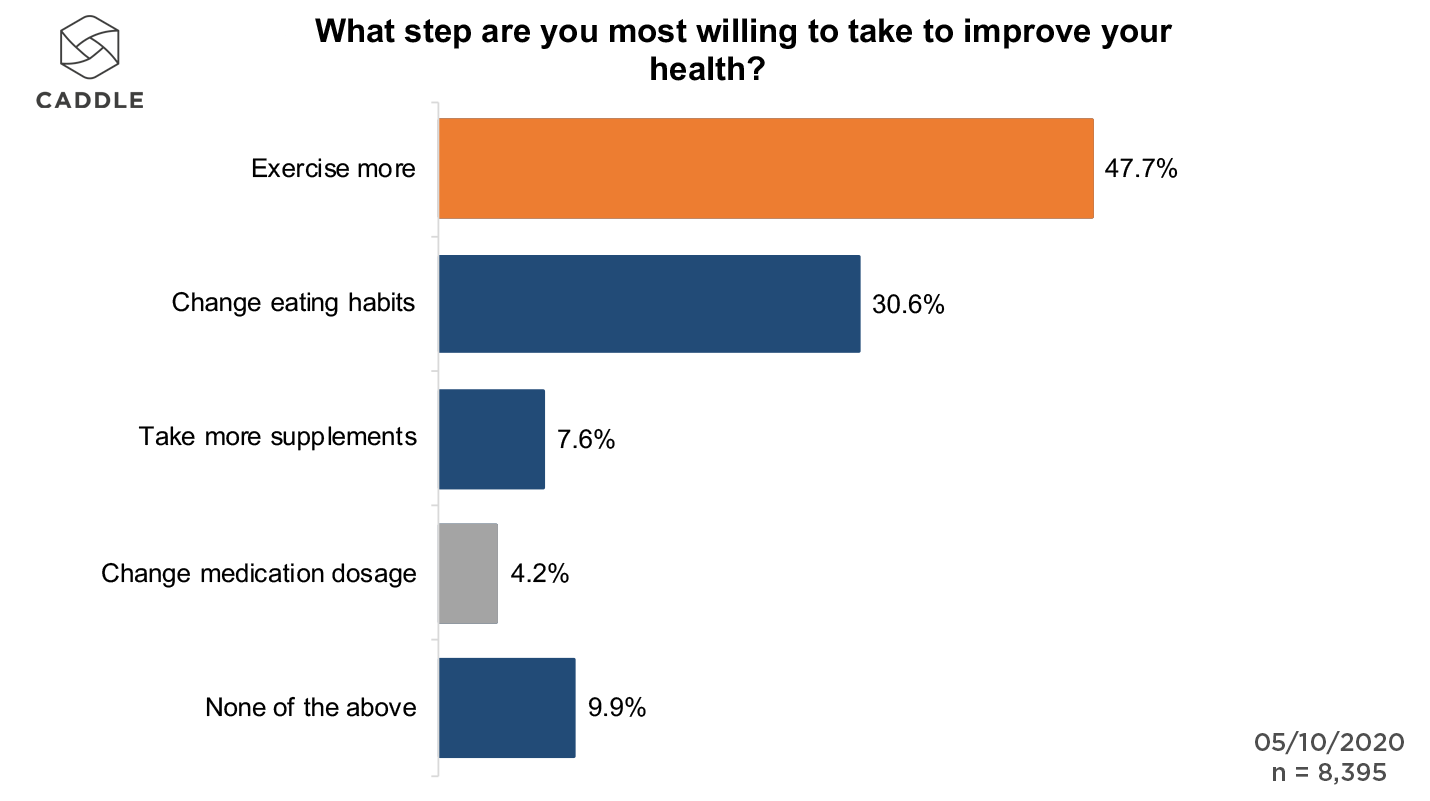
Interestingly, while the Greatest Generation are most willing to amp up their exercise regimen, they’re least willing to adapt their eating. (Admittedly, this could be an indication of the practicality of adding more exercise and nutritious food to their daily patterns.)
Now, let’s take a closer look at each of these—exercise, eating and supplements—in turn.
HOW IS COVID-19 SHAPING EXERCISE HABITS?
While 37% of respondents across the country are concerned about their fitness levels amid social distancing protocols, 43% indicated that they’re maintaining the same level of exercise as before COVID-19 hit Canadian populations. (By comparison, 27% of respondents say they’re exercising “more”/“a little more” and 30% are exercising “a lot less”/“a little less.”)
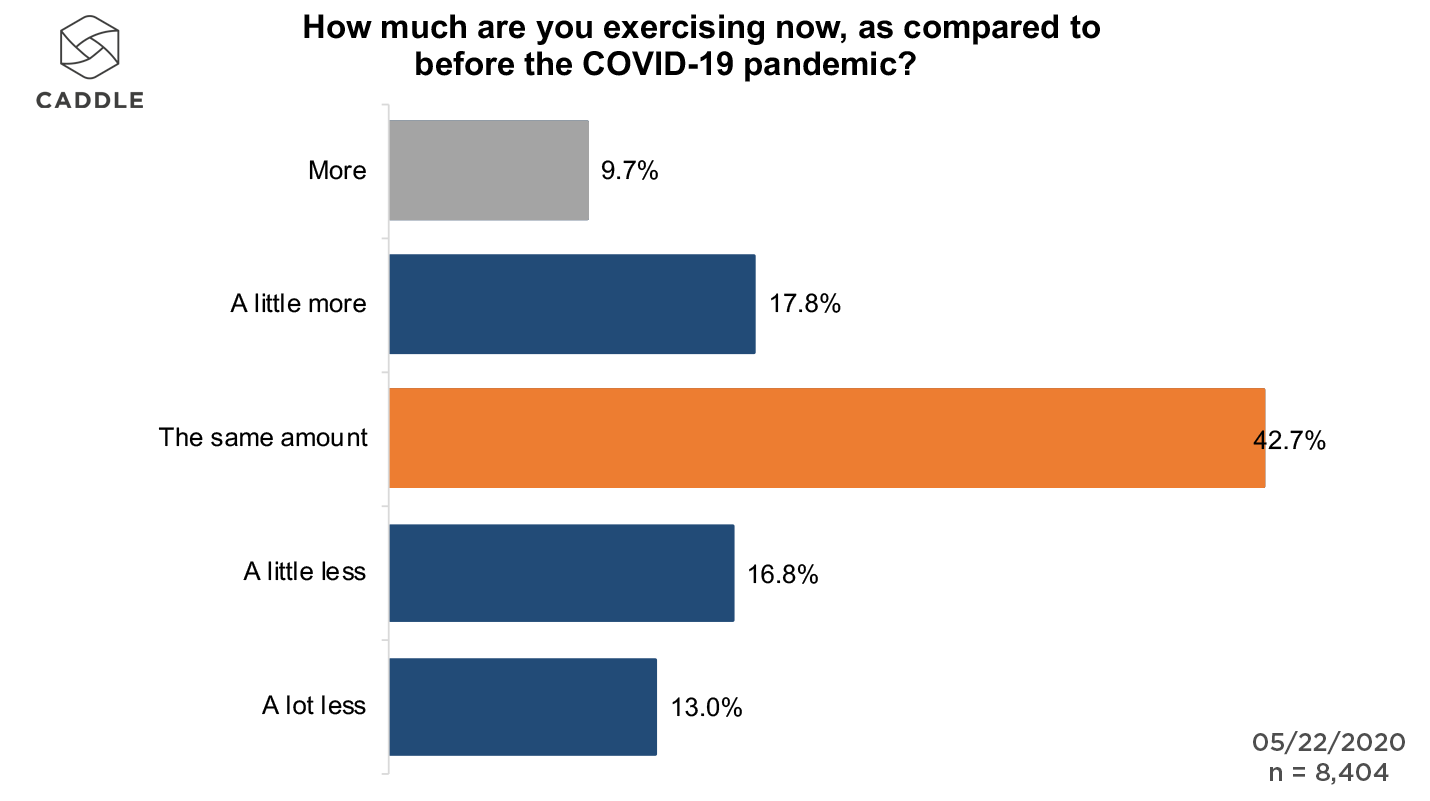
Which segments are exercising most during the pandemic compared to pre-COVID? Gen Zers, for one, almost 40% of whom are “more”/“a little more” active now than before.
Yet, based on that same survey, it looks like the fitness equipment boom that retailers witnessed earlier in the spring may have come to an end: An equal percentage of Caddle users are “very unlikely” as “unsure” about purchasing new home exercise equipment (25.8% and 25%, respectively), while only marginally more users responded positively (“very likely”/”somewhat likely”).
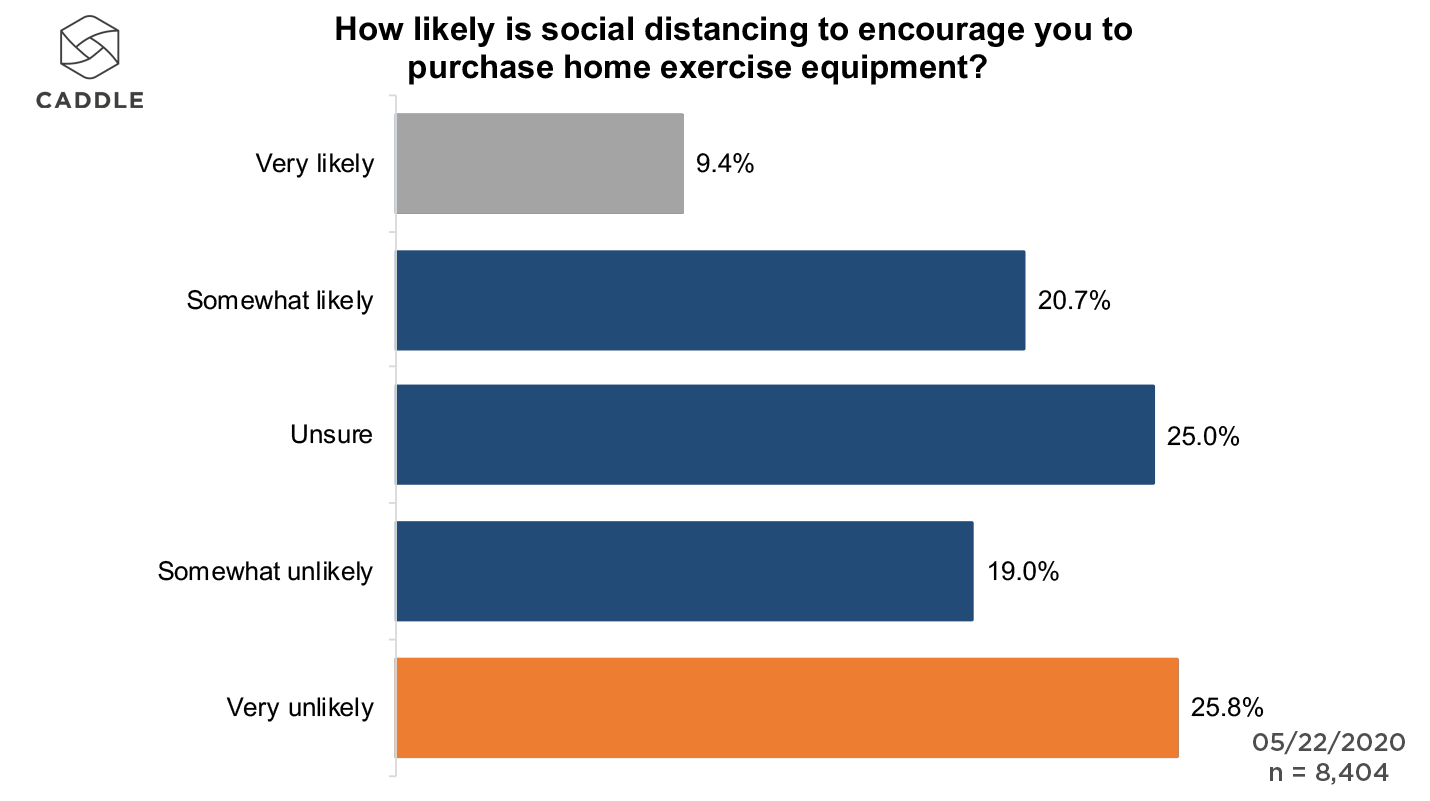
Be that as it may, the athleisure market continues to excel in the face of the social distancing, with nearly 15% of Caddle users anticipating the purchase of leisurewear once stores finally re-open to the public.
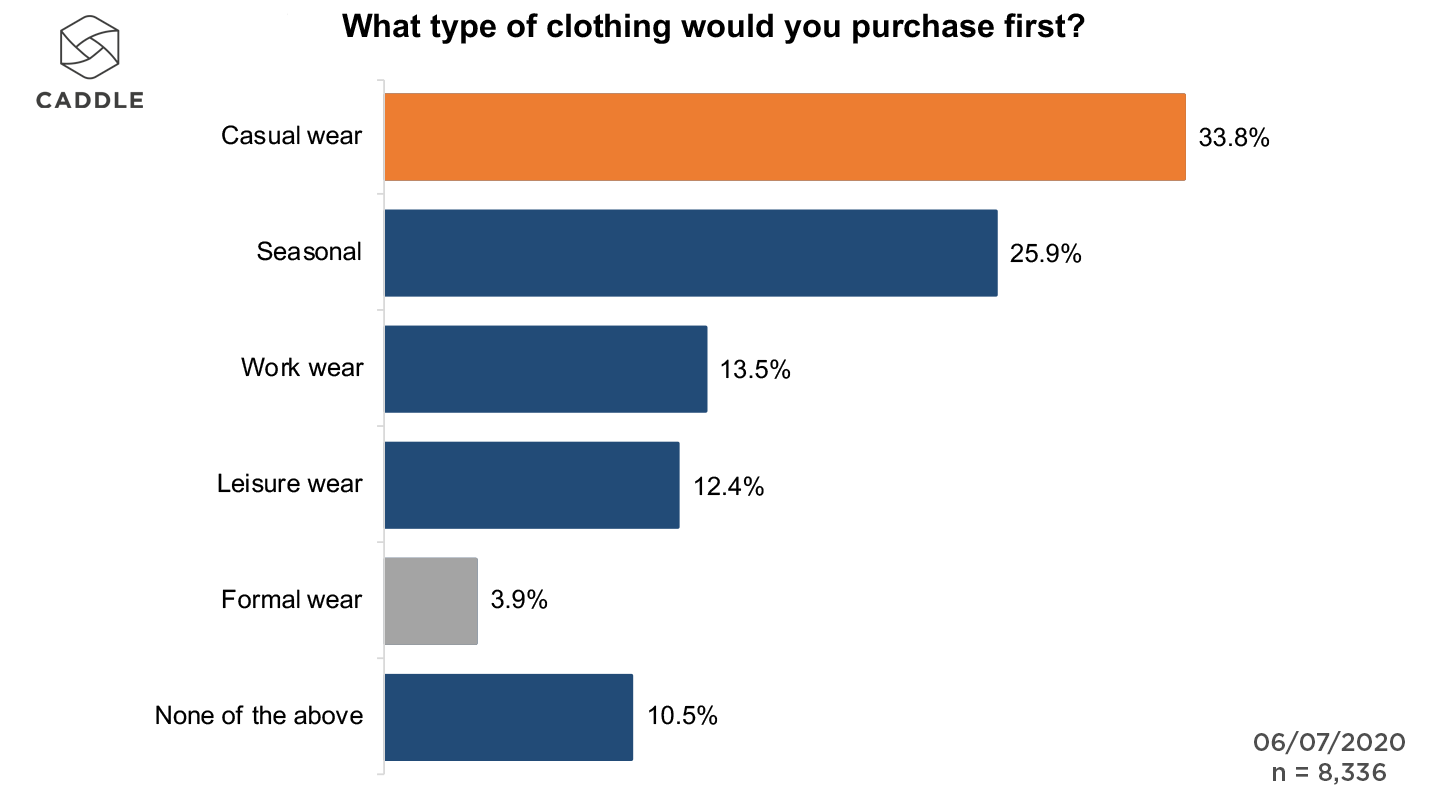
With 69% of respondents indicating that they exercised at home before social distancing curtailed their movement, we can deduce that they’re either not willing to spend their hard-earned cash on what might be considered a non-essential fitness equipment purchase. Or, perhaps they’re already equipped well enough at home to keep up their exercise regimens.
Does this pattern tie into consumption behaviour during COVID-19? Let’s explore the influence of the pandemic on eating habits.
HOW IS COVID-19 SHAPING EATING HABITS?
Based on surveys conducted during mid-May, healthy eating has become more important for almost half of our 8,252 respondents as a result of the pandemic. This is especially the case among Gen Zers located in Saskatchewan (67%), Quebec (63%) and Ontario (61%).
The question then is: Will increased interest in healthy eating extend beyond the pandemic?
Results indicate a resounding ‘yes,’ as almost three-quarters of Caddle users are interested in maintaining healthier eating habits post-COVID. This rises to 86% among respondents who placed greater importance on healthy eating during COVID.
What constitutes healthy eating for Caddle users? In short, a diet with fewer animal products and more fruits and vegetables. So, while 27% of respondents typically consume meat as part of any meal each week, 42% are interested in transitioning to a diet that includes less meat and dairy (Gen Zers are especially interested in going plant-based, at 51%).
At the same time, almost half of respondents expect to consume fruits and vegetables every day of the week.

This is about the same rate of consumption as a year before, though more than a quarter of Caddle users indicate that they’re consuming more fruits and vegetables than this time last year—especially respondents in the Yukon (40%) and Gen Zers in all regions (35%).
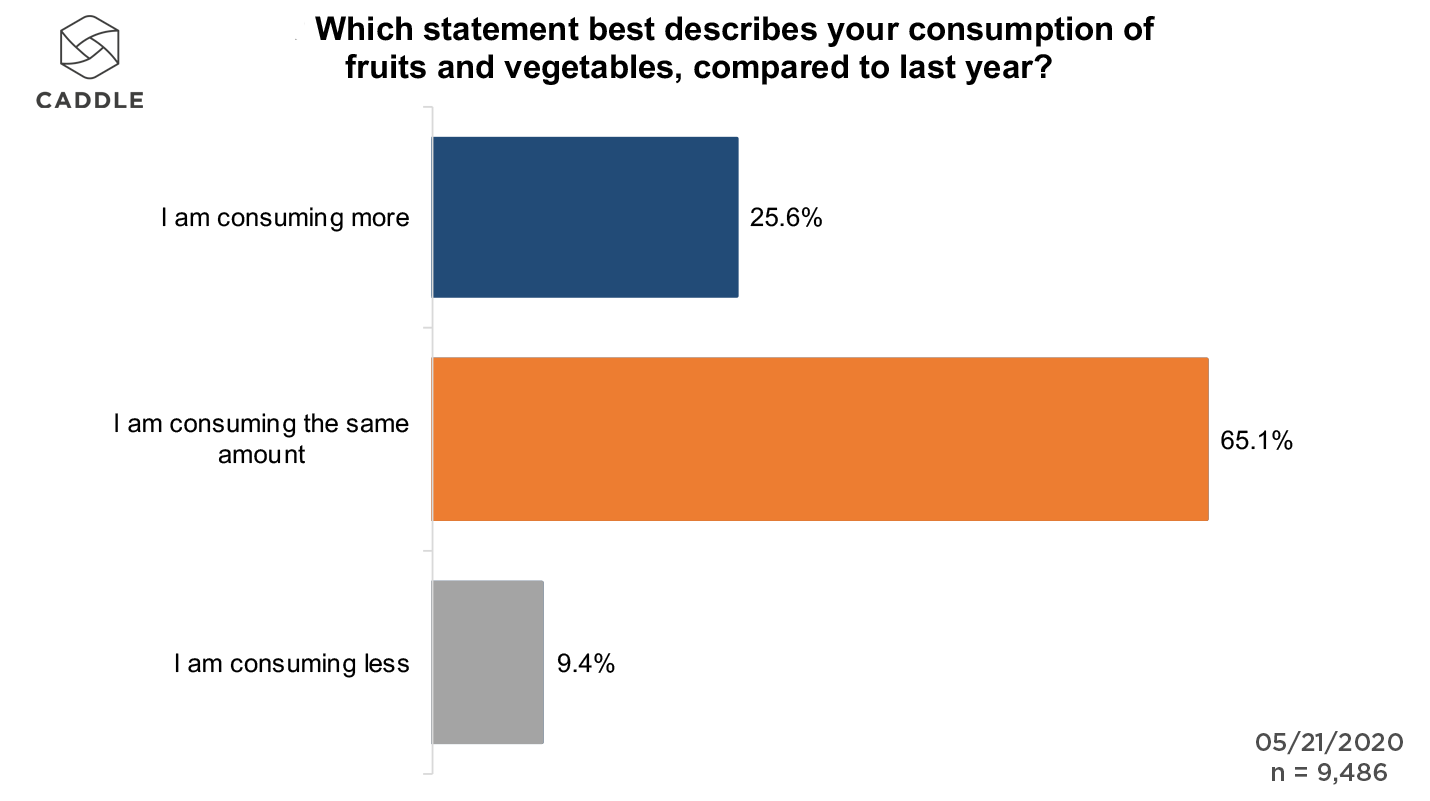
Interestingly, this dovetails with an increasing trend for Caddle users to cook at home more often than before: 100% of respondents who were cooking 1–4 times per week pre-COVID now report cooking 6–7 times per week during the pandemic, and 83% of respondents who cooked 1–2 times per week now find themselves cooking more often at home than before.
Now, with a significant proportion of Canadians opting for healthier food choices, we would expect to also see the same, if not greater, usage of supplements to keep diets as robust and healthful as possible.
Let’s go deeper into the statistics to see if this is the case.
HOW IMPORTANT ARE HEALTH SUPPLEMENTS TO CANADIANS?
Results from a daily survey on June 6th indicate that about 20% of respondents don’t consume dietary supplements. But, of the people who do, 16% expect to increase their consumption in the year ahead, while upwards of 58% expect to use the same amount.
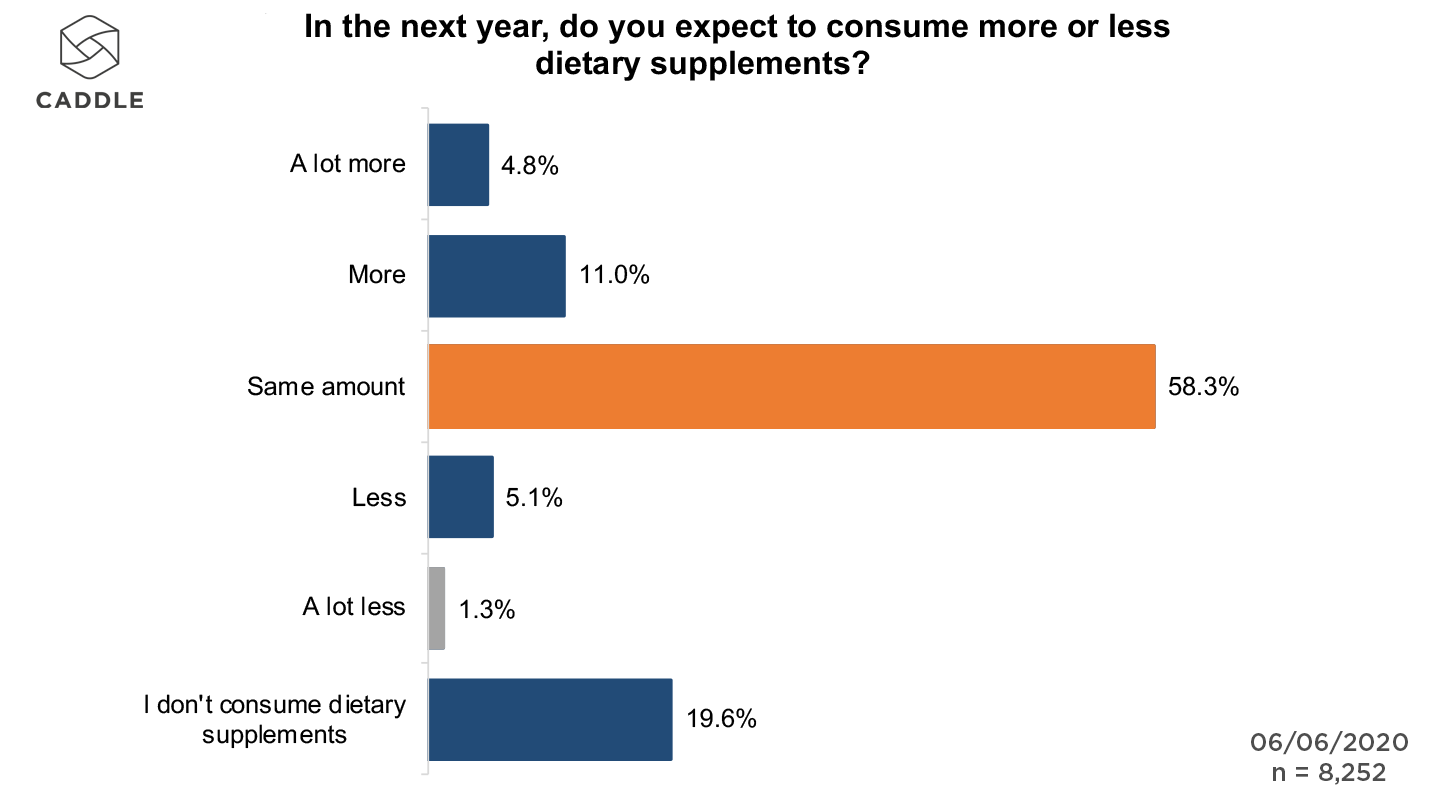
Gen Zers in the Prairies are outliers in this regard: Manitobans expect to increase their supplement consumption by 56%, while dietary supplementation among Saskatchewanians is expected to see a 50% increase in the coming months.
WHAT FACTORS COME INTO PLAY IN CONSUMERS’ HEALTH PRODUCT PURCHASING DECISIONS?
Canadian shoppers’ values differ when it comes to their preferred health and wellness products:
While upwards of 46% of consumers agree that a health brand’s reputation plays a role in their purchasing decisions, 60% of those same Caddle users argue that private label SKUs are just as good as premium-brand health products.
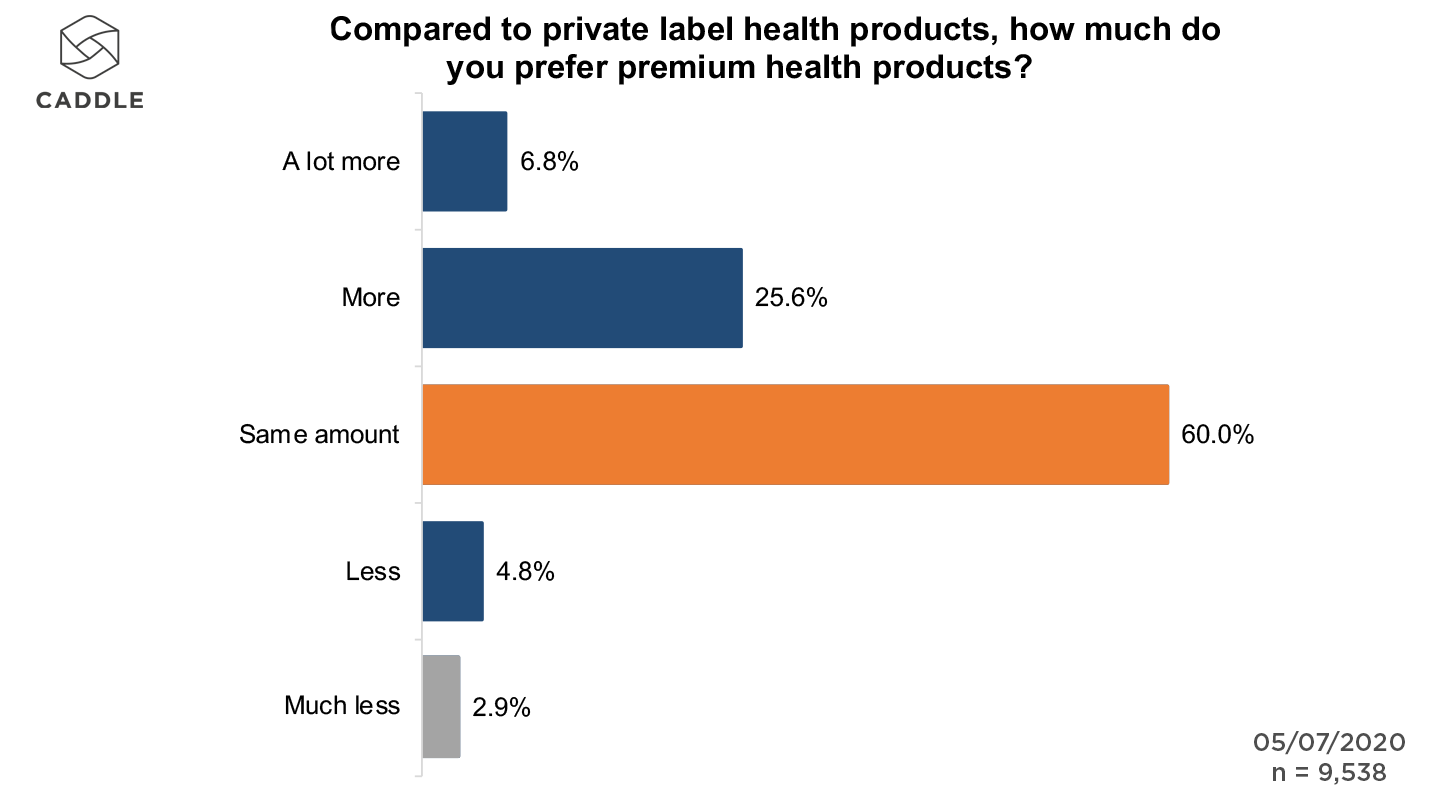
At the same time, premium products don’t seem to sway consumer preferences: Respondents are equally as likely (35.6%) to try new products to improve upon their health concerns as they are unsure (37.3%). (The most likely to try new health and wellness products? Millennials. And the least likely? The Greatest Generation, who perhaps are hesitant to spend money on untested products.)
Health product consumption extends to cannabis-based products, too: Since the onset of the pandemic, cannabis users on the Caddle panel have reported a slight increase in consumption; just over 25% told us that their usage had increased, compared to about 16% who reported a decline in usage.
When asked about the key factors that would prompt people to try CBD products, health benefits came out on top (at 30.7%), followed by doctor’s recommendation (at 20.1%).

This suggests that more Canadian consumers now look to cannabis-based products as an alternative but equally efficacious supplement that’s capable of improving their overall levels of health and wellbeing.
KEY TAKEAWAYS
COVID CONTINUES TO IMPACT CONSUMER WELLBEING (AND THAT’S AFFECTING PEOPLE’S EVERYDAY HABITS)
Amid ongoing concern for their physical and psychological health—as COVID case numbers rise and fall daily across the country—the majority of Canadian consumers are taking proactive measures to improve their overall health and wellbeing.
Whether they’re amping up their exercise regimens, seeking out more healthful food choices (including changing the composition of their diets and cooking at home more frequently), or enhancing their diets with health supplements, more Canadians are taking steps to look after themselves while continuing to social distance.
CANADIAN CONSUMERS ARE MAKING MORE HEALTHFUL FOOD CHOICES (AND IT’S EXPECTED TO STICK IN A POST-COVID WORLD)
With more shoppers now prioritizing product quality, freshness and “shop local” sourcing via farmers markets, it shouldn’t come as too big a surprise that Canadians are shifting away from predominantly animal-based meals and taking a greater interest in plant-rich diets. At the same time, they’re cooking more of their meals at home
While it’s unclear if cooking from home offers greater health benefits, or users are simply avoiding take-out or other meal solutions because of concerns over contamination (or for any number of other potential reasons), the retail sector can gain a stronger share of consumer budgets by catering to the at-home chef who’s looking for healthier food option, now and as COVID restrictions ease.
SUPPLEMENTATION IS A VIABLE METHOD OF MAINTAINING CONSUMERS’ HEALTH AND WELLBEING
A reported 80% of Caddle users use dietary supplements, and that number is expected to increase in the year ahead—particularly among consumers in the Prairie provinces. And while the premium nature of some health and wellness products doesn’t seem to sway consumers into increased purchases, brand reputation does.
This presents a novel opportunity for retailers and manufacturers alike to invest in strengthening the health and wellness claims on their products (both branded and private-label), to continue to drive consumer uptake through the tail end of the COVID pandemic and after.
